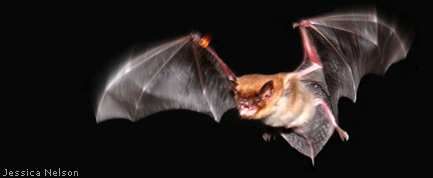Bats Shut Traps When Flying in Groups

Bats are known, in part, for making an infernal racket that helps them navigate, but it turns out they may actually flap around in relative silence when traveling in groups.
It's only for a microsecond, but the bats may actually take turns shutting up so they can listen to the leader and avoid the confusion caused by too many signals at once, new research suggests.
Back-seat echolocator
Bats navigate through a sonar-like process called echolocation, in which they emit high-frequency calls, then gauge the distance of objects around them by measuring how long it takes the echoes to bounce back.
Scientists wondered if these precise calculations could be thrown off when bats in packs are all making noise, since it may be difficult for bats to distinguish the echoes bouncing back from their own calls from the returning sounds emitted by their neighbors.
So Chen Chiu, Wei Xian, and Cynthia Moss of the University of Maryland recorded the cries emitted by pairs of bats flying in the lab, and found that up to 76 percent of the time at least one of the animals was quiet for more than 0.2 seconds.
"It doesn't sound like a long time, does it?" Moss said. "But in bat time, 0.2 seconds is a long time. Typically they're producing sounds with intervals of maybe 0.02 to 0.05 seconds."
Get the world’s most fascinating discoveries delivered straight to your inbox.
The interludes of silence were more frequent the closer the bats flew together, and the more similar their calls were to each other's.
Stealth fliers
The scientists can't be sure the bats' periods of hush were intended to avoid misjudging and flying into things, but it seems like a reasonable conclusion, Moss said.
"That's a working hypothesis," she told LiveScience. "It's also possible that they're trying to sneak up on the other one, showing some stealth behavior. Or they may be trying to save energy. But it seems like the most likely or dominant reason would be to minimize the jamming, and that’s 'cause they tend to do it more when their signals are more similar."
Since bats' echolocation measurements are so precise, it stands to reason that a competing signal from a nearby bat could throw one's calculations off course. If, for example, a bat mistook someone else's returning signal for his own, which had been sent out slightly sooner, he might think the object the sound was bouncing off of was a bit closer than it really was.
"We think they can use neighbor's calls and echoes for crude localization, but for the really precise localization that’s needed to capture an insect, they need to know where they were when they made the sound," Moss said.
The researchers detailed their findings in the Aug. 25 issue of the journal Proceedings of the National Academy of Sciences. The study was funded by the National Science Foundation, National Institute of Health, and William Hodos and Ann G. Wiley dissertation fellowships.
Air traffic control
If this silent treatment really is a method of air traffic control, it could explain a question that's been bugging bat scientists.
"These bats roost in groups and then they fly out from their roost very close together, so a lot of people have wondered how they manage to fly out in groups without being confused," Moss said. "It may be that under those situations, only a handful of bats are actually vocalizing and most of them are listening to each other's calls."
The behavior of bats varies from species to species, so the scientists would like to find out if other types of bats refrain from calling in the same way as the species they tested, the big brown bat (Eptesicus fuscus).
The researchers would also like to learn how the bats decide who gets to call and whose turn it is to shut up and listen.
"We don’t know," Moss said. "It tends to be the one who's flying behind. It may be easier to hear the vocalizations when [the caller] is flying behind. There's a lot we don’t know but this is an important first step to understanding the interactions of bats in groups."
- Video: How Bats Fly
- Forget Crystal Balls: Let the Power of Math Inform Your Future
- Bats Screech Louder Than Rock Concerts



